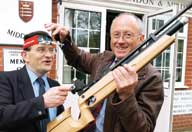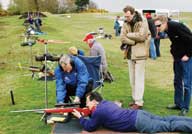Quaint chalets, a railway carriage complete with mini-station and rails and a multitude of oddly named and oddly shaped buildings played host to a recent Continuing Education and Training day
 Quaint chalets, a railway carriage complete with mini-station and rails and a multitude of oddly named and oddly shaped buildings played host to a recent Continuing Education and Training day
Quaint chalets, a railway carriage complete with mini-station and rails and a multitude of oddly named and oddly shaped buildings played host to a recent Continuing Education and Training dayThe location for the four-point day wasn’t Portmerion but the National Shooting Centre in Bisley, Surrey, and the subject, not surprisingly, was shooting and vision.
Introducing the Norville Eyewear-sponsored day, chairman Frank Norville said what delegates were about to hear wasn’t just about shooting vision it was about precision vision. The speaker for the session was optometrist and long-time shooting enthusiast Rainer Krischan from Austria.
His opening gambit was to discuss the various types of ametropia and then the different correction options available and discuss the best options for shooting.
While contact lenses might appear to be the most obvious option, they are not the best correction for shooters, said Krischan. This is because a contact lens moves on the eye, it also hastens tear film break-up which produces unstable vision.
Stability of vision is also a reason not to recommend orthokeratology, said Krischan, as the shooter’s correction will vary throughout a day’s shooting.
Surgery was also not recommended, not just because of the possible complications but also because of the potential for decreased contrast sensitivity. Returning to the topic of precision vision Krischan told the meeting that shooting was a stressful and tiring past-time for the eyes.
Aiming must take between four and eight seconds for the muscles of the eye not to tire too severely. Accuracy is paramount and corrections as small as 0.25D of power would affect results. A shooter may aim with one eye for an hour and 50 minutes and both the near and far fields of view and binocular vision must be taken into account if the shooter is to perform at his best. From his own experiences of conducting eye tests at shooting competitions, Krischan drew a series of observations.
One of the most interesting for the assembled optical audience concerned binocular vision. Krischan insisted binocular refraction and balance of accommodation was essential. ‘Sometimes I measure someone and monocularly they may be -0.25D or -0.5D, but binocularly the correction in the eye is +1.00.
‘For the best results the non-aiming eye should be corrected in a balanced way because it relieves the aiming eye between shots so the aiming eye can rest.’
He also insisted that testing has to be carried out using a trial frame, this allowed easier checks to be made against current spectacles and allowed changes in variables such as the angle of tilt or the inter-pupillary distance.
The next section of the talk focused on aiming views. Different types of weapons set up different visual scenarios, he said, changing the conditions a shooter might need to cope with and altering the importance of near, middle and far fields of view. In rifle shooting the eye should be 15mm to 20mm from the front sight. Correction at this point should allow the shooter to see the sights clearly, the target may be blurred. With a pistol, held at arm’s length, maybe a metre away, the front sight is a considerably greater distance from the eye. Problems in pistol shooting emerge earlier in a shooter’s life as the critical focus is further away. Clearly, different approaches must be taken for the addition and subtraction of power for the different disciplines. Having established what vision is required, Krischan looked at how that may be achieved.
Before the subject of corrective lenses, the Iris Diaphragm was discussed. This is a device which closes the aperture of view to increase the depth of sharpness. The downsides are a darker, narrower view, the need for the diaphragm to be exactly centred and the increased effects of any lens opacity in the eye.
For the ametropic shooter the critical nature of the aim has already ruled out contact lenses and orthokeratology which leads to spectacle lenses as the most suitable option. But for the lenses to be effective, account has to be taken of their positioning between the eye and the sights of the weapon.
Positioning of the correcting lens in just the right place is not always a simple matter given the unusual stances taken by some shooters. Every shooter will have to have their eyewear adjusted by a coach who stands at the business end of the weapon looking at the shooter from the perspective of the target.
This may allow for a ‘normal’ shape of frame to be used. If the shooter looks obliquely through the lens or through the edge of the lens the view will be distorted. This has led to the development of an array of frames which allow lenses, covers and shields to be mounted and positioned as needed.
The Winner range of products demonstrated at the CET day included arrangements which allowed one, two or sometimes three correcting lenses to be mounted on ‘rail’ arrangement along with shields, filters and diaphragms. Once mounted the lenses may then be adjusted to any distance, slant, tilt or angle to suit the shooter’s needs.
The lenses chosen, following binocular refraction, ‘have to be the best quality lenses with the best quality anti-reflection coating’, said Krischan. ‘We prefer glass. Covers for the non-aiming eye should be transparent.’
To enhance the visual performance further, colour filters can be placed in front of the corrective lenses or in the rear sight of the weapon. Filters can be used to reduce glare and increase contrast. In light conditions where the sun is shining onto the target an AC Blue filter may be suitable, in backlit conditions a Yellow 20 filter may be used. To achieve maximum brightness a Kalichrome yellow filter can be used, while specialist filters such as the CPF adjust to lighting conditions automatically.
Krischan finished off the session with a look at some of the health issues affecting shooters, such as tear film break-up and tired eyes. Techniques for improving tear film included not smoking, increased blinking, double blinking and the use of artificial tears.

For tired eyes, Krischan demonstrated the ‘figure of eight’ exercise and training the eyes to aim for shorter periods of time. For good measure, Krischan also showed the superior impact resistance of polycarbonate against CR39 when met by ricocheting pieces of metal.
The meeting then moved on to an informal session where delegates were invited to look at and try the Winner range of shooting optical appliances. The range included a massive array of frame and headband-mounted lens options. For all the styles adjustments to the lens’ position could be made in every direction which Rainer was happy to demonstrate.
Everyone is familiar with ‘shooting specs’ but the scope of the Winner range should not be underestimated. Practitioners with patients who shoot or take part in archery and other precision sports may well find a Winner frame mounting that is suitable for enhancing comfort and performance. Norville said a version of the Power Point presentation used by Krischan in his talk which was suitable for non-optometric people could be made available if required. After lunch the delegates got to put the theory into action with an afternoon’s shooting.
Four disciplines were tried: black powder pistols, 0.22 calibre target rifles, 12 bore shotguns at clays and full-bore rifles on the famous 1,000 yard range.
